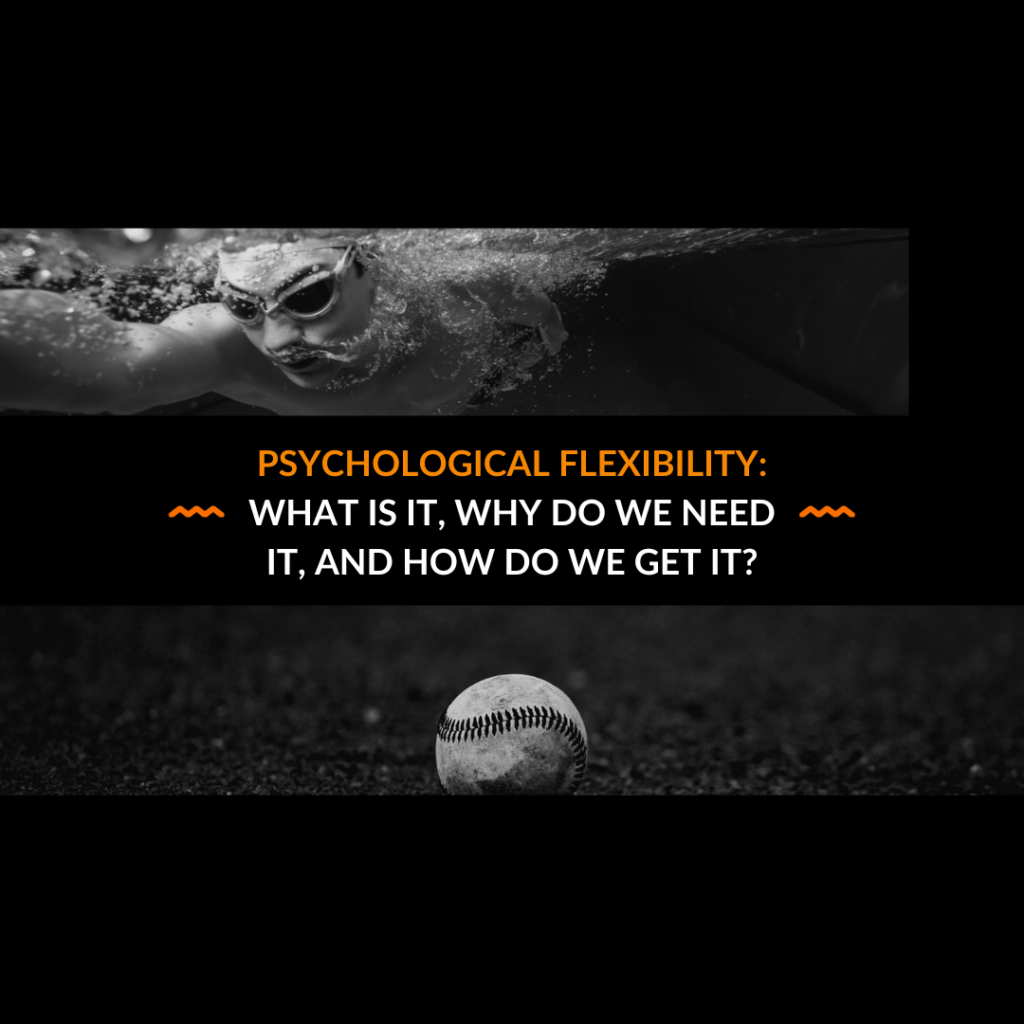My last blog post was on the topic of psychological safety and its role in an athlete’s experience. Now, I want to explore the concept of psychological flexibility (PF).
Perhaps the primary difference between the two concepts is that psychological safety (PS) is “other referenced” meaning an athlete depends on factors outside his or her self to get it. PF is wholly a “self referenced” concept. It is up to the individual to develop the skill of PF.
As I did with PS, I will first define PF to frame the conversation. One definition of PF is, “the ability to contact the present moment more fully as a conscious human being and to change or persist in behavior when doing so serves valued ends” (Chang et al., 2018, p. 45).
The reason why I’m exploring the topic of PF is that I am currently working with a college-bound high school athlete who has demonstrated signs of burnout because of a very fixed and self-judgmental mindset about his performance and what it means. Ultimately, the underlying issue that I’ve identified is that his identity is defined largely as an athlete – as opposed to student, teammate, friend, etc. Therefore, it only stands to reason when his performance isn’t what he hopes or expects of himself, it leads to negative thoughts and feelings which snowball into poorer performance. Rinse and repeat.
So, it got me thinking about how I can help him solve this problem, well, because it’s my primary responsibility as a mental performance coach. However, it’s just as much that I want this young man to genuinely find the love of his sport again.
As I normally will do, I formulated a hypothesis in my head based upon conversations in our coaching sessions along with some independent input from one of his parents. (We call this triangulation in sport psychology parlance). My hypothesis is that his athletic identity is leading to a hyper-judgmental, perfectionistic view of his performance. The next question that I asked myself is whether there is some research to lead me to an evidence-based intervention to help this young man.
My search for answers led me to a research article entitled, “The role of athletic identity in the development of athlete burnout: The moderating role of psychological flexibility.” Perfectly on-point. The next step was to figure out exactly what psychological flexibility means and then figure out how to get it. The definition of PF? Check. How do we build the PF “muscle”? Next. Keep reading.
The search for building PF led me back to the research library. Coincidentally, I found a research article entitled, “The mediating role of mindfulness in the relationship between cognitive flexibility and irrational performance beliefs of university student-athletes” (Tingaz, 2020).
Finding this particular article was serendipitous because one of my core philosophies of practice is that mindfulness (i.e., self-awareness) is the foundational skill required for athletes (or any performer) to gain control over their thoughts and emotions.
Fun fact: The subconscious brain processes 70,000 thoughts per day. We can’t control these thoughts that enter our minds, but we do have a choice in what to do with those thoughts. This choice is often the difference between a confident athlete and a self-doubting one. The article goes on to conclude that, “non-judgment had a partial mediating effect in the relationship between cognitive flexibility and irrational performance beliefs” (Tingaz, 2020, p. 1212). To translate, being able to non-judgmentally notice our thoughts is a part of the ability to work through the negative stories we tell ourselves.
At this point, I feel pretty comfortable introducing mindfulness to support my client’s effort to develop the skill of PF to address his challenges. So what exactly is mindfulness?
Perhaps the world’s most leading authority on mindfulness, Jon Kabat-Zinn, defines mindfulness as, “moment-to-moment, non-judgmental awareness, cultivated by paying attention in a specific way, that is, in the present moment, and as non-reactively, as non-judgmentally, and as open-heartedly as possible” (Tingaz, 2020, p. 1209).
So, what does that mean in more practical terms? It means that individuals need to practice getting better at not flogging themselves for every poor choice, poor performance, and random thought. The better we can get at seeing things objectively in the moment then the better the odds that we will be able to respond in a measured way rather than react in an overly emotional way. This is easier said than done, however, for two of reasons by my estimation.
The first reason is that the human brain is wired to judge thoughts as a defense mechanism. Our brain is always scanning for threats and our thoughts – when judged – often set off alarm bells for our brain. Thus, we move to formulating strategies to protect ourselves when it is likely that little to no threat truly exists. One example of this might be an athlete making a mistake in a game that they perceive to be catastrophic, but is largely inconsequential. It’s normal because they are human and typically, no one else thinks twice about it.
The second reason is that we develop patterns of thinking over the course of our lives. A 17-year old athlete has likely been thinking a certain way for as long as they are competing in their sport. Trying to break those patterns is hard. It requires intentional practice and patience. Doing this is hard because of the nature of sports. Athletes are focused on short-term performance and thus, often invest effort in the activities that they believe to have the most immediate impact. Sadly, mental training often falls to the back of the line.
Despite these challenges, my objective continues to be building PF through development of a mindfulness practice. So what does this look like?
First and foremost, if I give my young athletes too much to do then it is likely to lead to overwhelm and almost guarantee that the mindfulness practice will not take hold. So, I ask my clients to try five minutes of guided meditation per day. Five minutes. It only requires the athlete to download a mindfulness app like Headspace or Insight Timer onto their phone. I give them instructions on how to set it up and suggest that they formulate a routine that works for them. Ideally, they sit for five minutes in the morning before their day starts or five minutes at night before bed. Not too much to ask, right?
I love guided meditations because it provides gentle instruction on how to meditate. The process of building the non-judgment required to develop PF is built into the meditation. Such beginning meditations use words like, “notice” and “aware” frequently to prompt and encourage the participant to get comfortable with just being rather than trying to make sense of a thought or action. As the practice progresses, participants might be asked to identify and label thoughts and emotions to improve their awareness. Getting better at being present in the moment and slowing things down will improve the chances that PF can be developed in stressful situations.
To be honest, it is unclear if this approach will help my client in the current situation. Ultimately, he (or any client) must buy into and invest in the process of improving mindfulness to build PF. Part of the responsibility is mine to develop appropriate programming. However, part of the responsibility is his to execute the plan intentionally, to do the work, and demonstrate patience when perhaps the results are slow to come. Mental performance coaching is a true partnership.
I can speak from personal experience that building a mindfulness practice has led me to build PF. I was extremely inflexible in my thinking for most of my life. I used to judge myself harshly based on what I thought I should think, feel, and do. However, my rigid thinking progressed into a mental health disorder. I had a number of panic episodes and was diagnosed with Generalized Anxiety Disorder.
Part of the process of treating my anxiety was engaging in talk therapy. Ultimately, part of my treatment became taking medication even though I resisted it for many years. However, perhaps the biggest part of my treatment program was my mindfulness practice. I wouldn’t be in the mental performance coaching field if it wasn’t for my own experiences. I think everyone needs help from others to get to where they want or need to go in their lives. Yet, we don’t always have the luxury of mental health providers or pharmacological treatments. However, we always have ourselves as a resource. We need to develop PF in order to manage the weight of the stress that accumulates in our daily lives when no one else is there to help.
Jon Kabat-Zinn wrote a book entitled, “Wherever You Go, There You Are.” I think that pretty much sums it up. Without the ability to see yourself, see your thoughts, and see your emotions non-judgmentally, it will be very difficult to perform your best regardless of what you do. Engaging in mindfulness practice can be a small, but very powerful step to developing the PF needed to achieve your potential or just be happy in whatever you are doing.
So, what can student-athletes do to build PF?
- Look in the mirror. One of the most important catalysts for change is being honest with yourself. Am I too rigid in my thinking? Am I too hard on myself? Am I losing love for my sport? If the answer to any of these questions is yes, then being proactive about improving your mental game may be the next step. What that means for each individual will vary. However, a great first step might be five minutes of mindfulness meditation each day.
- Give yourself credit. It is all too common that young athletes hyper-focus on their shortcomings and mistakes: I should have done X, Y, and Z… Rather, try hard to think about all of the productive things that you have done or do every day to have put yourself in the position that you are now in. Get a piece of paper and write down all the “good” things. Start to give yourself credit. This will help you build your awareness and ultimately, your self-confidence.
- Just take one breath. Sometimes giving yourself PF in a moment just requires taking a deep, mindful breath. Focusing narrowly on the breath can eliminate distractions and create space to make good choices. Complexity isn’t always necessary to solve a problem. Sometimes, the answer is relying on simplicity (over and over again).
References
Chang, W.H., Wu, C., Kuo, C., & Chen, L.H. (2018). The role of athletic identity in the development of athlete burnout: The moderating role of psychological flexibility. Psychology of Sport & Exercise, 39, 45-51.
Tingaz, E.O. (2020). The mediating role of mindfulness in the relationship between the cognitive flexibility and irrational performance beliefs of university student-athletes. Current Psychology, 39(1), 1208-1214.

